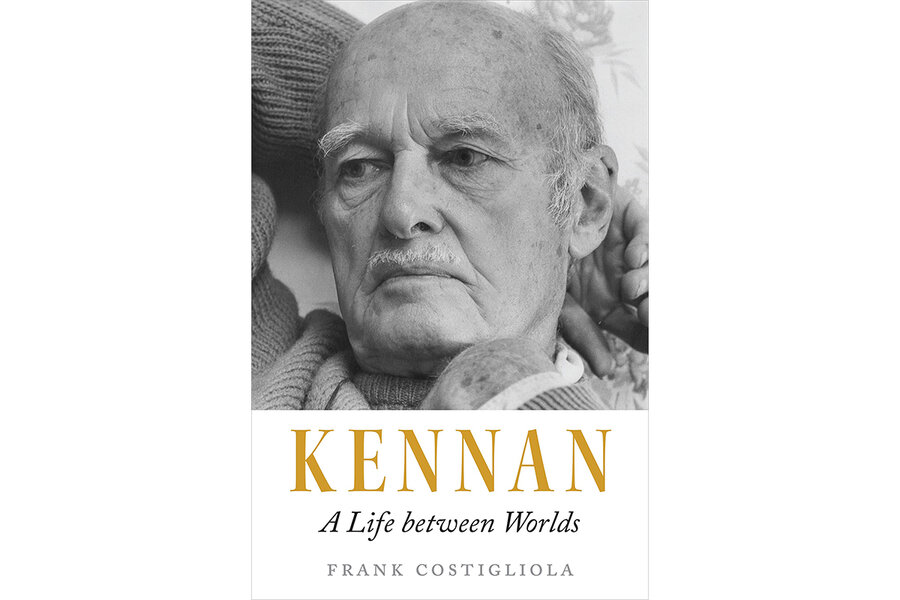Brilliant, prescient, troubled: The man behind Cold War containment
In the history of American foreign policy, few individuals have had the powerful and sustained impact of George F. Kennan. From the 1930s, when he helped open the first U.S. Embassy in the Soviet Union, until after the Soviet government collapsed some 60 years later, Kennan was the United States’ most influential analyst of Russia and its intentions. A new biography by Frank Costigliola, “Kennan: A Life Between Worlds,” offers a penetrating assessment of the accomplishments and character of this seminal figure.
As the extent of Soviet expansionism became clear after World War II, America faced a stark choice: either acquiesce and let more countries disappear behind the Iron Curtain or confront the Soviet Union militarily and run the risk of nuclear war.
As these debates raged, Kennan – already an experienced hand in the U.S. Embassy in Moscow – was asked to respond to a speech by Joseph Stalin. On Feb. 22, 1946, he dictated what quickly became known as the “Long Telegram,” which explained Soviet motivations and outlined a new strategy to gently but firmly respond to Soviet provocations.
Kennan was soon installed as the State Department’s first director of policy planning in an office next door to Secretary of State George Marshall where, among other things, he helped design the Marshall Plan. But most importantly, his 5,500-word telegram became the agency’s operating manual for engaging the Soviet Union across the globe.
In 1947, in an article in Foreign Affairs, he called on America to remain “cool and collected” and to refrain from “outward histrionics” while enforcing “a long-term, patient but firm and vigilant containment” of our ally-turned-adversary. Kennan believed that such a regimen would lead to the “moderation” or “mellowing” of Soviet power.
But Kennan’s plan had a second dimension that was quickly forgotten. After signaling the commitment to containment, Kennan wanted the U.S. to also engage in serious and sustained diplomacy to find a permanent solution to the post-war map in Europe.
Government policies – especially those dealing with existential threats – once set in motion are hard to redirect. Blocking the Soviets at every opportunity became the central goal of America’s foreign policy for the next four decades.
To the end of his long life (he died in 2005), he steadfastly and vociferously argued that the failure to move to diplomacy extended the Cold War and even increased the possibility of nuclear war. But as time passed, the consensus of the foreign policy establishment was that containment worked and produced the “long peace” that lasted until the Soviet Union collapsed. In short, Kennan lost control of the policy and the narrative.
Kennan was the ambassador to the Soviet Union during the Truman administration until, frustrated by lack of direction from Washington and an inability to engage with Russian officials, he lashed out and compared the Soviet Union to Nazi Germany. Stalin declared this man who deeply loved Russians and their culture “persona non grata.”
Kennan would later serve as ambassador to Yugoslavia in the Kennedy administration. He was often called upon for advice by government officials, but, for the most part, he spent the remainder of his career as a scholar at the Institute for Advanced Study in Princeton, New Jersey.
In later years, he was often in the news for his clear, sometimes contrarian, and prescient foreign policy advice. Beginning in the 1950s, he predicted that Soviet hegemony in Central and Eastern Europe would collapse. He was a very early critic of the war in Vietnam. When the Soviet Union did fall, he warned against the expansion of NATO, fearing that it would lead the Russians to feel surrounded by hostile, nuclear-armed forces. He thought the invasions of Afghanistan and Iraq could turn into quagmires. But while he received accolades and honors, “Kennan was not heeded,” Costigliola writes.
The author says he undertook the biography because he was “hooked by the distinction of Kennan’s writing and thinking, the quirkiness of his personality, and the turmoil of his inner life.” The Kennan that emerges is brilliant, creative, hardworking, and funny. But he also had a dark side. He was “cantankerous, cranky, and outrageously prejudiced” and “sensitive to criticism.”
Like other Kennan biographies, Costigliola focuses on his professional life and legacy. But the author is also adept at showing how Kennan’s personality shaped his professional life. Costigliola has given us a rich, insightful, and powerful portrait of this legendary American.








